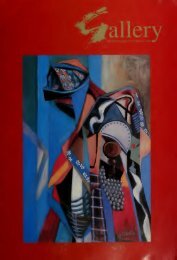Untitled - gallery delta
Untitled - gallery delta
Untitled - gallery delta
Create successful ePaper yourself
Turn your PDF publications into a flip-book with our unique Google optimized e-Paper software.
in the imagination to suggest vailing<br />
contemporary compositions and eciioes of<br />
melodies: combinations of traditional.<br />
European, urban, folk, modem and African.<br />
These objects are new musical instruments,<br />
never seen before. They evoke a new and<br />
very contemporary music.<br />
The human being is at the centre of their<br />
making. They are human in scale, much<br />
related in size to conventional instruments,<br />
intimate in detail and fragile in<br />
construction. They contain an uneasy<br />
tension caused partly by the insecure ties<br />
that hold them together and partly by the<br />
incongruity of their elements. They are<br />
contradictory, seem ready to fall/fly apart.<br />
Their components are connected but not<br />
fused, retaining their distinct features. The<br />
belonging of the parts to the whole remains<br />
tenuous and reminds us of their continuing<br />
transience. They can be read as metaphors<br />
for personal identity and. in this, the artist's<br />
own biography is a key.<br />
Keston Beaton was bom in 1 %.'' in<br />
Zimbabwe but of immigrant parents from<br />
Malawi whose conversion to Anglicanism<br />
led them to name their son after a Scottish<br />
missionary. After school in one of colonial<br />
Harare's high-density suburbs. Beaton spent<br />
18 months at the BAT Workshop where he<br />
was taught by Paul Wade, hmi.self the son of<br />
Jamaican and English mixed parentage, who<br />
worked within the more open approach of<br />
British art education. Later he joined<br />
Tapfuma Gutsa's Utonga Workshop where<br />
he began "scratching on stone ... but it was<br />
not lis fluent as I ihoiiglu and I left art. " His<br />
experimental nature could not fit in with the<br />
established current of stone sculpture in<br />
Zimbabwe so he tried, for five years, to<br />
make ends meet through different trades<br />
which included watch making and repairing.<br />
During this time he continued to produce<br />
some pieces, to see exhibitions and was<br />
struck by the work of visiting British artist,<br />
Anne Carrington. whose use of scrap<br />
materials caught his attention and sent him<br />
back to art.<br />
Similar multiple, cross-cultural strands are<br />
woven into almost all Zimbabweans'<br />
Keston Beaton, Stone Harp, 1995, approx. 90 x 70 x 15cm,<br />
found objects<br />
identities and find expression in Beaton's<br />
work. The bits of each instmment bring<br />
with them not only musical correspondences<br />
but also social and historical references.<br />
Memories cling to the bits - their origins,<br />
making, place/use and significance in other<br />
contexts. These are open-ended. Each<br />
viewer brings his/her own recollections to<br />
each bit. The relationships between bits<br />
shift as the viewer contemplates them and<br />
alter their meanings in the process.<br />
For example in the Stone Harp we are<br />
presented with a form reminiscent perhaps<br />
of a lyre, of David's harp from the Bible or<br />
of other folk instruments yet the form is<br />
constmcted of curving kudu horns which are<br />
essentially African. The strings are<br />
combinations of wire, cotton and plastic.<br />
and the resonators/rattles and other elements<br />
are manufactured metals and plastics as well<br />
as wood. The ancient and natural, religious<br />
and secular, are connected to the modem<br />
and industrial.<br />
In Harp ( 1998) a section of old carved<br />
fumiture. European and probably 50s<br />
colonial, forms a sounding board for<br />
curiously constmcted strings with a cur\'ing<br />
bow/handle of amalgamated strips of<br />
different materials. On this instmment there<br />
are bone, wood and silver rings which refer<br />
directly to different sections of societies and<br />
histories.<br />
(Top) Keston Beaton, King David's Harp, 1997,<br />
approx. 90 X 70 X 15cm, found objects<br />
(Bottom) Keston Beaton, Harp, 1998,<br />
approx. 70 x 45 xlOcm, found objects<br />
15







